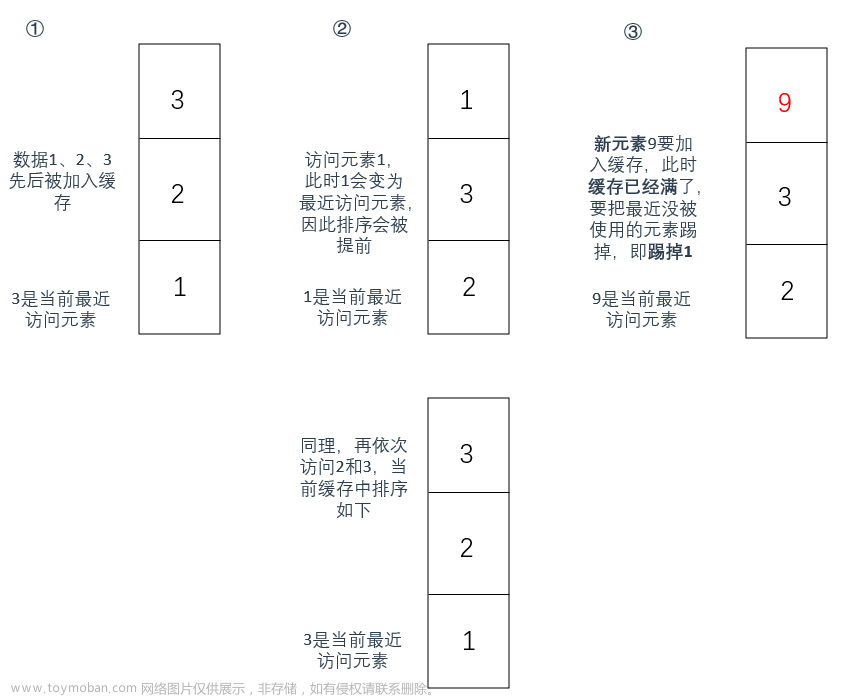双向链表接口设计
/**
* @file name: 双向链表接口设计(非循环接口)
* @brief
* @author ni456xinmie@163.com
* @date 2024/04/23
* @version 1.0 :
* @property :
* @note
* CopyRight (c) 2023-2024 ni456xinmie@163.com All Right Reseverd文章来源:https://www.toymoban.com/news/detail-856724.html
*/文章来源地址https://www.toymoban.com/news/detail-856724.html
构造双向循环链表结构体
// 指的是双向链表中的结点有效数据类型,用户可以根据需要进行修改
typedef int DataType_t;
// 构造双向链表的结点,链表中所有结点的数据类型应该是相同的
typedef struct DoubleLinkedList
{
DataType_t data; // 结点的数据域
struct DoubleLinkedList *prev; // 直接前驱的指针域
struct DoubleLinkedList *next; // 直接后继的指针域
} DoubleLList_t;
创建一个空双向链表并初始化
DoubleLList_t *DoubleLList_Create()
{
// 1.创建一个头结点并对头结点申请内存
DoubleLList_t *Head = (DoubleLList_t *)calloc(1, sizeof(DoubleLList_t));
if (NULL == Head)
{
perror("Calloc memory for Head is Failed");
exit(-1);
}
// 2.对头结点进行初始化,头结点是不存储数据域,指针域指向NULL
Head->prev = NULL;
Head->next = NULL;
// 3.把头结点的地址返回即可
return Head;
}
创建新的结点,并对新结点进行初始化
DoubleLList_t *DoubleLList_NewNode(DataType_t data)
{
// 1.创建一个新结点并对新结点申请内存
DoubleLList_t *New = (DoubleLList_t *)calloc(1, sizeof(DoubleLList_t));
if (NULL == New)
{
perror("Calloc memory for NewNode is Failed");
return NULL;
}
// 2.对新结点的数据域和指针域(2个)进行初始化
New->data = data;
New->prev = NULL;
New->next = NULL;
return New;
}
功能函数:从首节点进行插入元素
bool DoubleLList_HeadInsert(DoubleLList_t *Head, DataType_t data)
{
DoubleLList_t *new = DoubleLList_NewNode(data);
DoubleLList_t *tmp = Head->next;
if (Head->next == NULL) // empty list 链表为空的情况
{
Head->next = new;
return true;
}
new->next = Head->next; // normal situation 普通情况
Head->next->prev = new;
Head->next = new;
return true;
}
功能函数:从尾部插入新元素
bool DoubleLList_TailInsert(DoubleLList_t *Head, DataType_t data)
{
DoubleLList_t *new = DoubleLList_NewNode(data);
DoubleLList_t *tmp = Head->next;
if (Head->next == NULL) // judge is the null 链表为空的情况
{
Head->next = new;
return true;
}
while (tmp->next != NULL) // as the normal situation,find the last node 普通情况,遍历寻找最后的节点
tmp = tmp->next;
tmp->next = new; // 在尾部插入节点
new->prev = tmp;
return true;
}
功能函数:从指定位置插入新元素
bool DoubleLList_DestInsert(DoubleLList_t *Head, DataType_t destval, DataType_t data)
{
DoubleLList_t *tmp = Head->next;
DataType_t i = Head->data;
if (Head->next == NULL) // judge the empty list 链表为空的情况
{
printf("The list is empty,there is no destival.\n");
return false;
}
DoubleLList_t *new = DoubleLList_NewNode(data);
while (destval != tmp->data && tmp->next != NULL)
// as the normal situation,find the destval找到目标值
{
tmp = tmp->next;
}
if (destval == tmp->data) // 如果存在目标值,则进行插入操作
{
new->next = tmp->next;
tmp->next->prev = new;
new->prev = tmp;
tmp->next = new;
return true;
}
else // 如果不存在目标值,则插入无效,直接返回
{
printf("There is no destval\n");
return false;
}
}
功能函数:删除首节点
bool DoubleLList_HeadDel(DoubleLList_t *Head)
{
// 对链表的首结点的地址进行备份
DoubleLList_t *Phead = Head->next;
// DoubleLList_t *tmp = Head->next;
if (Head->next == NULL) // 判断当前链表是否为空,为空则直接退出
{
printf("current linkeflist is empty!\n");
return false;
}
Head->next = Phead->next; // delete the head 直接进行删除首节点操作
Phead->next = NULL;
Phead->prev = NULL;
Head->next->prev = NULL;
free(Phead);
return true;
}
功能函数:删除尾部节点
bool DoubleLList_TailDel(DoubleLList_t *Head)
{
DoubleLList_t *tmp = Head->next;
if (Head->next == NULL) // 判断当前链表是否为空,为空则直接退出
{
printf("current linkeflist is empty!\n");
return false;
}
while (tmp->next != NULL) // find the last node 普通情况,遍历寻找最后的节点
{
tmp = tmp->next;
}
tmp->prev->next = NULL; // 此处应考虑,是否需要增加一个变量记录目标值直接前驱
tmp->prev = NULL;
tmp->next = NULL;
free(tmp);
return true;
}
功能函数:删除指定位置的节点
bool DoubleLList_MidDel(DoubleLList_t *Head, DataType_t destval)
{
DoubleLList_t *tmp = Head->next;
if (Head->next == NULL) // 判断当前链表是否为空,为空则直接退出
{
printf("current linkeflist is empty!\n");
return false;
}
while (tmp->data != destval && tmp->next != NULL) // find the specific node找到指定值的节点
{
tmp = tmp->next;
}
if (tmp->data == destval && tmp == Head->next)
{
Head->next = tmp->next; // 如果存在目标值,且目标值位于首节点时,进行头删操作
Head->next->prev = NULL;
tmp->next = NULL;
tmp->prev = NULL;
free(tmp);
return true;
}
else if (tmp->data == destval) // 如果存在目标值,且目标值不位于首节点时,进行删除操作
{
tmp->prev->next = tmp->next;
tmp->next->prev = tmp->prev;
tmp->prev = NULL;
tmp->next = NULL;
free(tmp);
return true;
}
else // 如果不存在目标值,则直接返回
{
printf("The is no destival\n");
return false;
}
}
功能函数:遍历打印链表
bool DoubleLList_Print(DoubleLList_t *Head)
{
// 对链表头结点的地址进行备份
DoubleLList_t *Phead = Head;
// 判断当前链表是否为空,为空则直接退出
if (Head->next == Head)
{
printf("current linkeflist is empty!\n");
return false;
}
// 从首结点开始遍历
while (Phead->next)
{
// 把头结点的直接后继作为新的头结点
Phead = Phead->next;
// 输出头结点的直接后继的数据域
printf("data = %d ", Phead->data);
// 判断是否到达尾结点,尾结点的next指针是指向首结点的地址
if (Phead->next == Head->next)
{
break;
}
}
return true;
}
主函数,调用并测试各功能函数
int main(int argc, char const *argv[])
{
DoubleLList_t *H = DoubleLList_Create();
DoubleLList_HeadInsert(H, 20);
DoubleLList_HeadInsert(H, 30);
//DoubleLList_HeadInsert(H, 10);
DoubleLList_TailInsert(H, 40);
DoubleLList_TailInsert(H, 20);
DoubleLList_TailInsert(H, 50);
DoubleLList_DestInsert(H, 30, 31);
DoubleLList_DestInsert(H, 32, 31);
DoubleLList_Print(H);
puts("");
DoubleLList_HeadDel(H);
printf("1\n");
DoubleLList_TailDel(H);
printf("2\n");
DoubleLList_MidDel(H, 31);
printf("3\n");
DoubleLList_Print(H);
puts("");
return 0;
}
到了这里,关于双向链表接口设计的文章就介绍完了。如果您还想了解更多内容,请在右上角搜索TOY模板网以前的文章或继续浏览下面的相关文章,希望大家以后多多支持TOY模板网!



![[JS与链表]双向链表](https://imgs.yssmx.com/Uploads/2024/02/450947-1.png)









